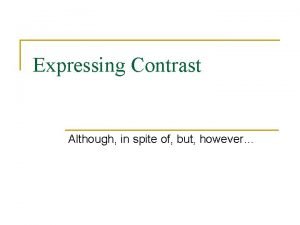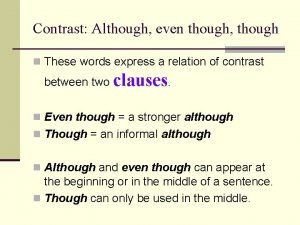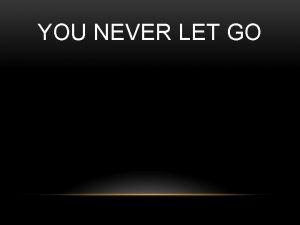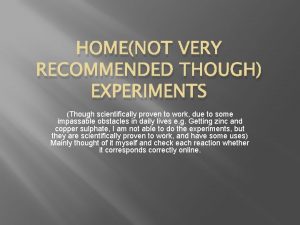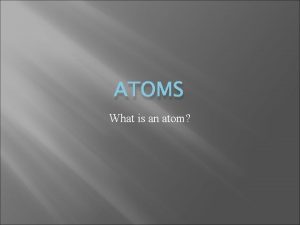The Atom Even though atoms are very small









- Slides: 9

The Atom Even though atoms are very small, they are made up of even smaller things. You can learn a lot about the parts that make up an atom and what holds an atom together. What you should be able to do after studying this lesson/chapter: 1. Describe the size of an atom. 2. Name the parts of an atom. 3. Describe the relationship between numbers of protons and neutrons and atomic number. Vocabulary: 1. Proton - a subatomic particle that has a positive charge and that is located in the nucleus of an atom; the number of protons in the nucleus is the atomic number, which determines the identity of an element 2. Atomic mass unit - a unit of mass that describes the mass of an atom or molecule 3. Neutron - a subatomic particle that has no charge and that is found in the nucleus of an atom 4. Atomic number - the number of protons in the nucleus of an atom; the atomic number is the same for all atoms of an element 5. Mass number - the sum of the numbers of protons and neutrons in the nucleus of an atom 6. Atomic mass - the mass of an atom expressed in atomic mass units

In this section, you’ll learn about how atoms are alike and how they are different. But first you’ll find out just how small an atom really is. How Small Is an Atom? Think about a penny. A penny contains about 2 × 1022 atoms (which can be written as 20, 000, 000, 000 atoms) of copper and zinc. That’s 20 thousand billion atoms— over 3, 000, 000 times more atoms than there are people on Earth! If there are that many atoms in a penny, each atom must be very small. Scientists know that aluminum is made of average-sized atoms. An aluminum atom has a diameter of about 0. 00000003 cm. That’s three one-hundred-millionths of a centimeter. Even things that are very thin, such as aluminum foil, are made up of very large numbers of atoms.

What Is an Atom Made Of? As tiny as an atom is, it is made up of even smaller particles. These particles are protons, neutrons, and electrons. (The particles in the pictures are not shown in their correct proportions. If they were, the electrons would be too small to see. )

The Nucleus Protons are positively charged particles in the nucleus. The mass of a proton is about 1. 7 × 10 – 24 g. This number can also be written as 0. 00000000000017 g. Because the masses of particles in atoms are so small, scientists made a new unit for them. The SI unit used to express the masses of particles in atoms is the atomic mass unit (amu). Each proton has a mass of about 1 amu. Neutrons are the particles of the nucleus that have no electrical charge. Neutrons are a little more massive than protons are. But the difference in mass is so small that the mass of a neutron can be thought of as 1 amu. Protons and neutrons are the most massive particles in an atom. But the volume of the nucleus is very small. So, the nucleus is very dense. If it were possible to have a nucleus the volume of a grape, that nucleus would have a mass greater than 9 million metric tons!

Outside the Nucleus Electrons are the negatively charged particles in atoms. Electrons are found around the nucleus within electron clouds. Compared with protons and neutrons, electrons are very small in mass. It takes more than 1, 800 electrons to equal the mass of 1 proton. The mass of an electron is so small that it is usually thought of as almost zero. The charges of protons and electrons are opposite but equal, so their charges cancel out. Because an atom has no overall charge, it is neutral. What happens if the numbers of electrons and protons are not equal? The atom becomes a charged particle called an ion (IE ahn). An atom that loses one or more electrons becomes a positively-charged ion. An atom that gains one or more electrons becomes a negatively-charged ion.

How Do Atoms of Different Elements Differ? There are more than 110 different elements. The atoms of each of these elements are different from the atoms of all other elements. What makes atoms different from each other? To find out, imagine that you could build an atom by putting together protons, neutrons, and electrons. Starting Simply It’s easiest to start with the simplest atom. Protons and electrons are found in all atoms. The simplest atom is made of just one of each. It’s so simple it doesn’t even have a neutron. To “build” this atom, put just one proton in the center of the atom for the nucleus. Then, put one electron in the electron cloud. Congratulations! You have just made a hydrogen atom.

Now for Some Neutrons Now, build an atom that has two protons. Both of the protons are positively charged, so they repel one another. You cannot form a nucleus with them unless you add some neutrons. For this atom, two neutrons will do. To have a neutral charge, your new atom will also need two electrons outside the nucleus. What you have is an atom of the element helium. A helium nucleus must have neutrons in it to keep the protons from moving apart.

Building Bigger Atoms You could build a carbon atom using 6 protons, 6 neutrons, and 6 electrons. You could build an oxygen atom using 8 protons, 9 neutrons, and 8 electrons. You could even build a gold atom with 79 protons, 118 neutrons, and 79 electrons! As you can see, an atom does not have to have equal numbers of protons and neutrons. Protons and Atomic Number How can you tell which elements these atoms represent? The key is the number of protons. The number of protons in the nucleus of an atom is the atomic number of that atom. All atoms of an element have the same atomic number. Every hydrogen atom has only one proton in its nucleus, so hydrogen has an atomic number of 1. Every carbon atom has six protons in its nucleus. So, carbon has an atomic number of 6.

Section Summary • Atoms are extremely small. Ordinary-sized objects are made up of very large numbers of atoms. • Atoms consist of a nucleus, which has protons and usually neutrons, and electrons, located in electron clouds around the nucleus. • The number of protons in the nucleus of an atom is that atom’s atomic number. All atoms of an element have the same atomic number. • The mass number of an atom is the sum of the atom’s neutrons and protons Show the other atom PPT.
